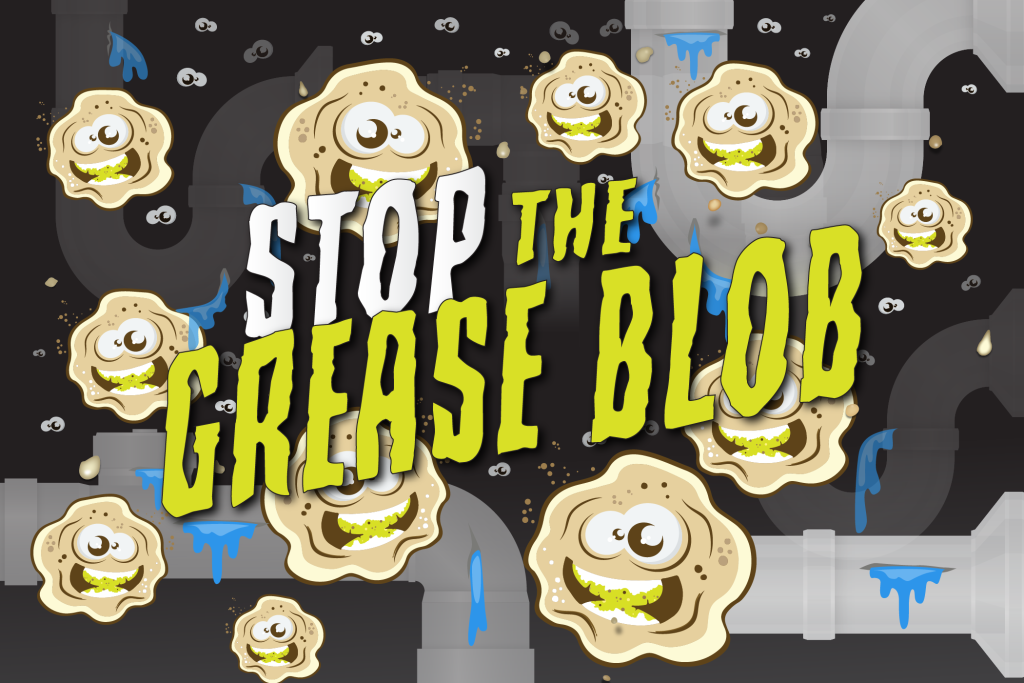
Pouring cooking oil or grease down the drain sticks to the insides of the wastewater pipes and creates a gooey-gross Grease Blob. The more you feed him the bigger he gets until he causes a monster of a clog. Help stop the Grease Blob from causing expensive repairs, foul odors and sanitary sewer overflows!
- Sources of Fats, Oils, & Grease (FOG)
-
FOG can come from a variety of animal fats and/or vegetable oils that are used to prepare food or are found in food. You may be surprised at the variety of everyday foods that can contain FOG and can cause issues with plumbing. Examples include:
- Meat Fats (Bacon, Sausage, etc.)
- Sauces & Gravy
- Cooking oils (Canola, Corn etc.)
- Yogurt
- Butter/Margarine
- Mayonnaise
- Nut Butters
- Salad Dressing
Did you know?
- Many oils solidify at lower temperatures and, even those that don't, often bind to other forms of fats and grease. Even those that don't, often bind to other forms of FOG and other articles, such as “flushable” wipes, already in the pipes.
- Natural oils in some food items, like nuts, can be released when put through the garbage disposal? Because of this and that the small size of food particles produced by a garbage disposal can make them even more likely to cling to pipes, it is always best to put food scraps in the compost or trash.
- Proper FOG Disposal to Help Stop the Grease Blob
-
Proper disposal of Fats, Oils and Grease (FOG) can not only save you money, but also help protect the environment by reducing the number of clogged pipes and sanitary sewer overflows.
Restaurants in the Austin area have grease traps, also known as grease interceptors, which are designed to separate FOG along with solids normally found in food preparation waste from being discharged as wastewater to the City's sanitary sewer system. However, most residences do not have such devices, so proper FOG disposal is vital. Please see below for best FOG disposal practices.
Always:
- Use a paper towel to wipe grease from pots, pans, plates, and utensils prior to washing.
- Scrape food scraps into the trash, not the sink or garbage disposal (unfortunately, very greasy and oily food cannot be composted).
- Use a sink strainer to catch food particles from entering the drain.
Small Quantities of FOG:
- Collect small quantities of cooking oil and/or grease in an empty can, used jar, or similar container. Be sure the container used has a lid, so the FOG doesn't pour out. Once full:
- Schedule an On-demand Hazardous Waste Collection pick-up (each service address can schedule up to three collections per service every calendar year). Or,
- Discard in the trash. If using a can, please place it in a plastic bag before discarding.
- Alternatively, the FOG can be mixed with kitty litter, and double bagged before discarding in the trash.
Large Quantities of Residential FOG:
- Drop Off: Drop off used cooking oil at Austin Resource Recovery’s Recycle & Reuse Drop-off Center (2514 Business Center Drive, Austin, TX 78744). Drop-off is currently by appointment only.
- Pick-up (Limited to 30-gallons): Schedule an On-demand Hazardous Waste Collection pick-up with Austin Resource Recovery. Each service address can schedule up to three (3) collections per service every calendar year.
For safety reasons, used cooking oil dropped off or picked-up must be in 5- gallon (or smaller) containers.
Restaurants:
- Austin City Code Chapter 15-10 details various grease trap related requirements, including cleaning the grease trap, and hauling the waste off-site, as well as the potential consequences of non-compliance. For more information, visit Austin Water's Grease Trap Maintenance webpage.
- What Can Happen When FOG Goes Down the Drain?
-
Fats, Oils, and Grease (FOG), including food scraps sent through the garbage disposal, flow through the sanitary sewer system much like bad cholesterol in the human body. In both pipes and human arteries, FOG can accumulate and constrict flow and potentially cause blockages. In addition, the FOG can stick to other items in the pipes that were flushed instead of discarded in the trash, such as wipes (even those marked as “flushable”) and paper towels.
FOG that accumulates on the insides of the wastewater pipes can cause very costly repairs for both homeowners and the City as well as threats to public health and the environment in the form of sewage back-ups & sanitary sewer overflows (SSO).
The City of Austin is under an Administrative Order from the United States Environmental Protection Agency (EPA) to address persistent problems with SSOs. Because of this and to ensure the safe and unimpeded transport of raw wastewater to the City's wastewater treatment plants, SSO prevention is vital. In addition to disposing of FOG correctly, you should also Only Flush Toilet Paper.
Below are some pictures of sanitary sewer overflows showing build-up of FOG in pipes and the effects of that build-up.
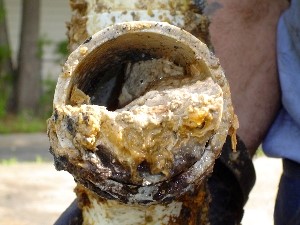
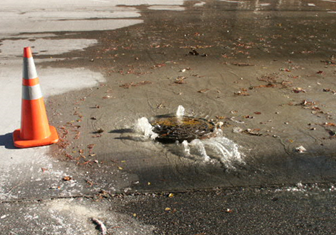
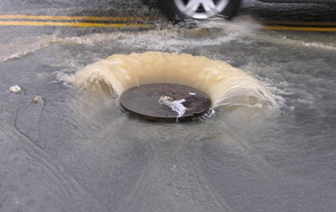
- Common FOG Disposal Myths
-
- Myth #1: It is okay to put sources of Fats, Oils, and Grease down the drain if using the garbage disposal.
Truth: Garbage disposals only grind up the greasy, fatty foods into smaller particles, which can make it even easier for it to cling to pipes.
Resolution: Always scrape food scraps from dirty dishes, pots, and pans into the trash or compost.
- Myth #2: Using hot water and soap to rinse dishes and remove the grease residue left on plates is sufficient to prevent a clog in the pipes.
Truth: Hot water and soap may serve only to push the potential clog further down the pipe, often meaning that the eventual blockage may be even more costly to repair.
Resolution: Wipe dirty dishes with a paper towel before rinsing and use as little chemicals and soap as possible to maintain a sanitary kitchen.
- Myth #3: It is okay to flush wipes down the toilet if they are labeled “Flushable”.
Truth: Just because something says “Flushable” doesn’t mean it should be flushed. Flushable wipes have been retrieved fully intact after at least 30 minutes of travel time through the sewer system. And any FOG poured down the drain can cling to the wipes in the pipes, which can lead to a “Fatberg”.
Resolution: Wipes should be properly disposed of in the trash, not the toilet. For more information, visit the Only Flush Toilet Paper webpage.
- Myth #1: It is okay to put sources of Fats, Oils, and Grease down the drain if using the garbage disposal.
- Community Outreach Events
-
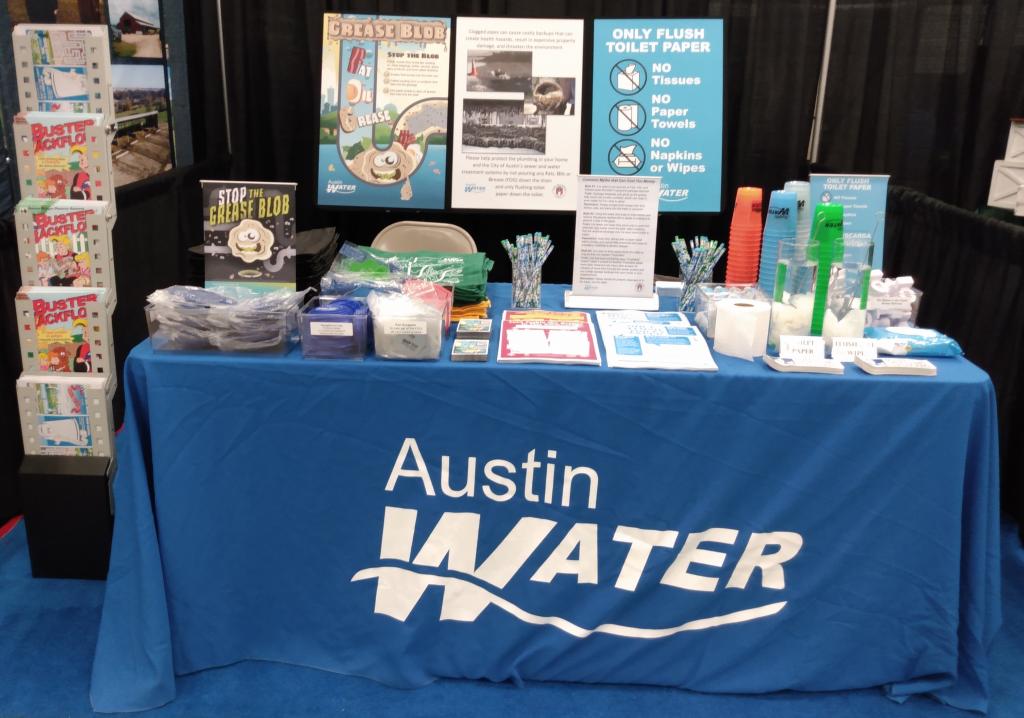 The Austin Water Utility Compliance Services Division (UCSD) regularly participates in community events to educate the public about how to “Stop the Grease Blob” and to “Only Flush Toilet Paper”.
The Austin Water Utility Compliance Services Division (UCSD) regularly participates in community events to educate the public about how to “Stop the Grease Blob” and to “Only Flush Toilet Paper”.At these events, the UCSD offers free items to help you dispose of fats, oils and grease (FOG) at your residence and free educational materials for children.
If you are interested in having the Austin Water UCSD participate at your event, please email event details to elizabeth.coy@austintexas.gov.
Note: A request does not guarantee availability.Community Outreach Photos
Please view photos from past events in the Austin Water UCSD Community Outreach Flickr Collection. - Holiday FOG Tips
-
FOG should not be poured down the drain any time of the year, but it is especially important to remember during the
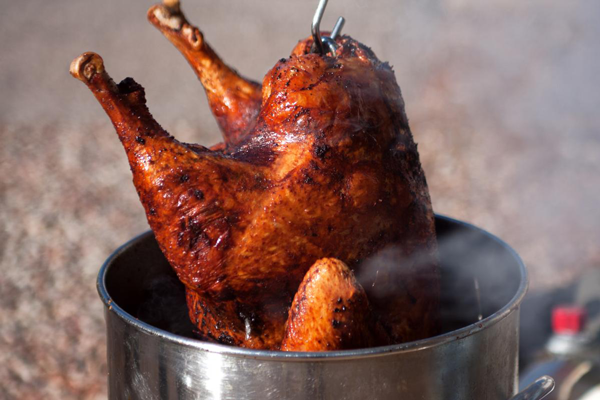 busy holiday season. The good news is proper disposal of holiday-meal related FOG is easy and benefits the entire City of Austin!
busy holiday season. The good news is proper disposal of holiday-meal related FOG is easy and benefits the entire City of Austin!Austin Resource Recovery will accept used cooking oil in 5-gallon (or smaller) containers.
- Drop Off: Drop off used cooking oil at Austin Resource Recovery’s Recycle & Reuse Drop-off Center (2514 Business Center Drive, Austin, TX 78744). Drop-off is currently by appointment only. To schedule an appointment, visit http://www.austintexas.gov/dropoff
- Pick-up (Up to 30-gallons): Schedule an On-demand Hazardous Waste Collection pick-up. Each service address can schedule up to three (3) collections per service each calendar year.
Once collected at the Recycle & Reuse Drop-off Center, the oil is poured into a 100-gallon tank. A vendor then picks up the tank and processes the used cooking oil into biodiesel, which is a more safe, biodegradable and clean burning transportation fuel than petroleum-based diesel.
For small amounts of FOG, proper disposal is as easy as 1-2-3!
- Let the FOG cool.
- Place it in a sealed container (such as an empty coffee can or pasta sauce jar).
- Toss the sealed container into the trash.
Please also use a paper towel to wipe grease from pots, pans, plates and utensils prior to washing. And remember to dispose of the paper towels in the trash, never flush them down the drain.
- Drop Off: Drop off used cooking oil at Austin Resource Recovery’s Recycle & Reuse Drop-off Center (2514 Business Center Drive, Austin, TX 78744). Drop-off is currently by appointment only. To schedule an appointment, visit http://www.austintexas.gov/dropoff
- Grease Blob Frequently Asked Questions
-
Why are cooking oils and grease a problem for wastewater pipes?
Fat, cooking oil and grease (FOG) are only partially soluble in water and are not compatible with wastewater piping. If poured down the drain, these substances thicken, coagulate, and stick to the drainage piping, forming gooey-gross deposits that grow each time additional greasy waste enters the pipes.Whether these deposits form in the homeowner's wastewater pipes or the city sanitary sewer lines, the result is a clogged pipe and costly repairs. These blockages may also be accompanied by foul odors, significant property damage, and even environmental harm.
What is the difference between oil and grease?
The terms are often used interchangeably, but they are very different substances. Oil, such as vegetable or olive oil, is liquid and never turns into a solid. Grease is the solid residue leftover in the cooled pan after frying meat, such as bacon.Why are oils that do not solidify a problem?
Many oils do solidify at lower temperatures and therefore clog the drainage system. Even if oils don't solidify, they often bind to other forms of fats and grease.What are the common mistakes people make when disposing of cooking oils and grease?
When many people are finished cooking, they tend to dump leftover cooking oil, grease, and/or food scraps down the sink and turn on the garbage disposal. The truth is that garbage disposals only grind up the greasy, fatty foods into smaller particles, which can make it even easier for it to cling to pipes.Another common mistake is rinsing dishes in the sink with hot water and soap to remove the grease residue left on plates. Hot water and soap may serve only to push the potential clog further down the pipe, often meaning that the eventual blockage may be even more costly to repair. It is best to use as little chemicals and soap as possible to maintain a sanitary kitchen.
Does it really make a difference if I pour just a little grease down the drain?
Yes, based on an estimated population of 978,908 (U.S. Census, 7/1/2019), if every person in Austin poured just one teaspoon of FOG down the drain, it would be the equivalent of dumping nearly 1,275 gallons of FOG into the sewer.Will Austin Resource Recovery pick up FOG at my house?
Yes, Austin Resource Recovery (ARR) customers may schedule an on-demand household hazardous waste collection, which includes cooking oil and grease, up to three (3) times per calendar year. Note, individual containers larger than five (5) gallons cannot be collected and there is a 30-gallon limit for the total amount of materials collected during each scheduled collection. For more information or to schedule a pick-up, visit ARR’s On-demand Bulk, Brush and Household Hazardous Waste Collection webpage.
Where is the Austin’s Resource Recovery’s Recycle & Reuse Drop-off Center located if I want to drop off a container of FOG to be recycled? And, is there a cost to do so?
Austin’s Resource Recovery’s Recycle & Reuse Drop-off Center is located at 2514 Business Center Drive, Austin, TX 78744. Drop off of your household hazardous waste for safe disposal or reuse is free for Austin and Travis County residents (fees apply if you do not live in Austin or Travis County). Appointments to drop off can be made online.What about restaurants or large quantities of cooking oil and grease?
For restaurants, or large quantities of grease, learn about Austin Water’s Grease Trap Program.
Forms and Resources
YOUTH ACTIVITIES AND EDUCATIONAL MATERIALS
- Stop the Grease Blob Full-Color Poster
- Stop the Grease Blob Coloring Page
- Grease Blob Coloring Page
- Dowser Dan Activity Sheet (English/Spanish)
OTHER RESOURCES
- Grease Blob Handout
- Grease Blob Handout (en español)
- Multi-Family Property Grease Blob Brochure
- Multi-Family Property Grease Blob Brochure (en español)
- Report a Sanitary Sewer Overflow at 512-972-1000

